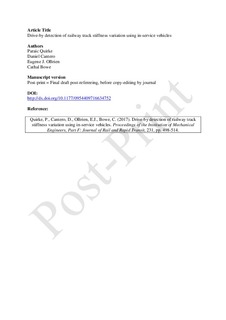Drive-by detection of railway track stiffness variation using in-service vehicles
Journal article, Peer reviewed
Accepted version
Permanent lenke
http://hdl.handle.net/11250/2492435Utgivelsesdato
2017Metadata
Vis full innførselSamlinger
Originalversjon
Proceedings of the Institution of mechanical engineers. Part F, journal of rail and rapid transit. 2017, 231 (4), 498-514. 10.1177/0954409716634752Sammendrag
Railway track stiffness is an important track property which can help with the identification of maintenance related problems. Railway track stiffness can currently be measured using stationary equipment or specialised low-speed vehicles. The concept of using trains in regular service to measure track stiffness has the potential to provide inexpensive daily ‘drive-by’ track monitoring to complement data collected by less-frequent monitoring techniques. A method is proposed in this paper for the detection of track stiffness variation through an analysis of vehicle accelerations resulting from the vehicle–track dynamic interaction. The cross-entropy optimisation technique is applied to determine the track stiffness profile, which generates a vehicle response that best fits the measured vertical accelerations of a railway carriage bogie. Numerical validation of the concept is achieved by using a two-dimensional half-bogie dynamic model, representing a railway vehicle, to infer a global track stiffness profile along a track. The track stiffness measurement algorithm is implemented in Matlab. This paper reports the results of the numerical simulations. The proposed method gives good estimates of the track stiffness. To the authors’ knowledge, this is the first time an optimisation technique has been applied to the determination of railway track stiffness.
